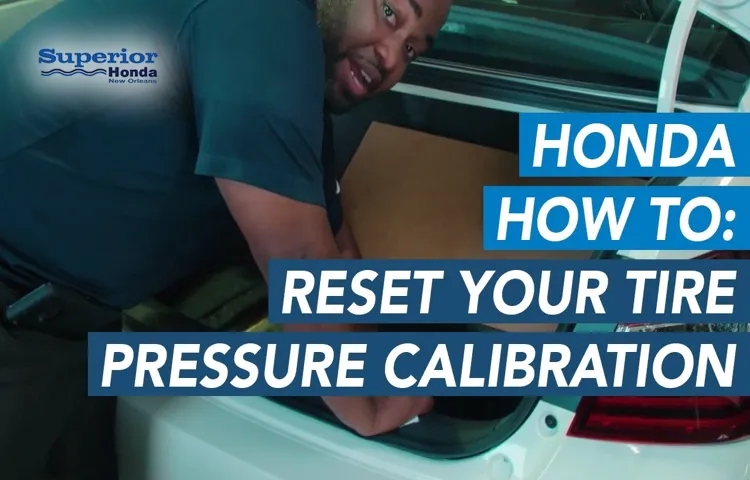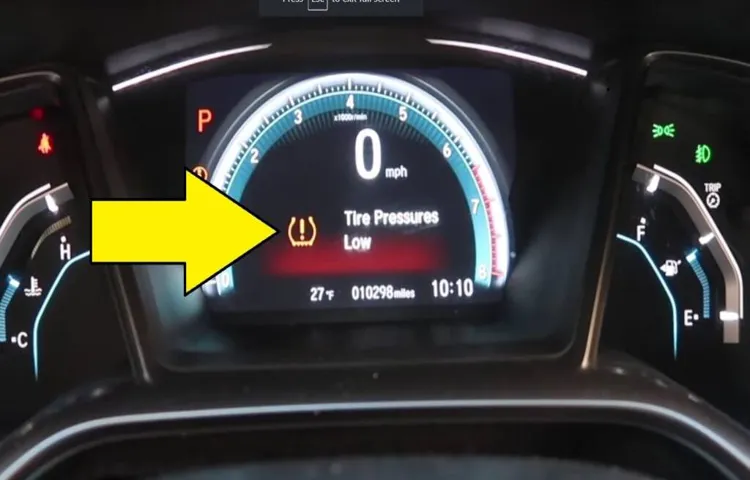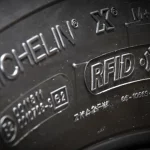Does your Honda Civic’s tire pressure light keep coming on, even after filling the tires? Or maybe you just want to ensure that your car is running at its best performance. Well, you’ve come to the right place. In this article, we’ll guide you through the steps on how to calibrate your Honda Civic tire pressure, so you can drive with confidence and security.
Tire pressure plays a crucial role in a car’s performance, safety, and fuel efficiency. That’s why it’s important to make sure that your tire pressure is in check. Lucky for you, calibrating Honda Civic tire pressure is a quick and straightforward process that can be done at home with a few easy steps.
Whether you’re a seasoned car enthusiast or a first-time car owner, this article will provide you with all the information you need to carry out this task easily and efficiently. So, let’s get started and ensure that your Honda Civic’s tire pressure is at its optimum level.
Table of Contents
Introduction
If you own a Honda Civic, it’s essential to keep your tires calibrated to maintain safety on the road and improve your car’s performance. The tire pressure affects the car’s handling, fuel efficiency, and overall ride comfort. Luckily, calibrating your Honda Civic’s tire pressure is a relatively easy process.
The first step is to find the recommended tire pressure for your car, which you can typically find in the owner’s manual or on a sticker on the driver’s side door jamb. Once you have this information, use a tire pressure gauge to check the pressure of each tire. If the pressure is too high or too low, adjust it to the recommended level by adding or releasing air using an air compressor.
Remember to recheck the pressure after making the adjustment to ensure it’s correct. Taking the time to calibrate your Honda Civic’s tire pressure regularly can help ensure that your car runs smoothly and safely on the road.
Explanation of tire pressure calibration
Tire pressure calibration is the practice of ensuring that your vehicle’s tire pressure is set correctly according to the manufacturer’s recommendations. Proper tire pressure is essential to maintain optimal driving performance, fuel efficiency, and most importantly, safety on the road. Incorrect tire pressure can lead to uneven tire wear, decreased handling and control, and increased risk of a blowout.
It is crucial to check your tire pressure regularly, especially before long trips or when you notice changes in your vehicle’s handling. Most vehicles have recommended tire pressure levels listed in the owner’s manual or on the inside of the driver’s side door. It is also important to note that tire pressure should be checked when the tires are cold, or before driving the car for the day.
An easy way to remember tire pressure is to think of it like a balloon – too much air can cause it to pop, and too little can make it weak and ineffective. Therefore, keeping a properly calibrated tire pressure can make all the difference in your vehicle’s performance and safety.

Why it is important for your Honda Civic?
Honda Civic Introduction: Honda Civic is one of the most popular and well-known cars on the road today. It has been around for over four decades and has undergone numerous changes and updates since its introduction in 197 The Civic has been known for its reliability, fuel efficiency, and affordable price tag.
But why is it so important for your Honda Civic to be properly maintained? Let’s take a closer look.
Gathering the Necessary Tools
When it comes to calibrating the tire pressure on your Honda Civic, it’s important to have the necessary tools on hand. Firstly, you’ll need a tire pressure gauge to check your current tire pressure levels. Make sure to use a reliable and accurate gauge, as using a faulty one can lead to incorrect readings.
Secondly, you’ll need an air compressor to add or release air from your tires as needed. It’s also recommended to have a tire inflator with a built-in pressure gauge for convenience and accuracy. Lastly, don’t forget to have a tire repair kit nearby in case of any punctures or damages to your tires.
By having these tools ready, you’ll be able to easily calibrate your Honda Civic’s tire pressure and maintain optimal driving performance.
Tire pressure gauge and inflator
In order to ensure that your tires are functioning optimally, it’s essential to have a tire pressure gauge and inflator on hand. However, before you jump in and start using these tools, it’s important to gather some additional materials. First off, make sure you have the correct type of tire pressure gauge for your vehicle, as there are variations depending on the type of tire you have.
Additionally, you’ll need to have access to an air compressor or a can of pressurized air to refill your tires once you’ve identified that they need filling. Finally, make sure you have safety gear on hand, such as gloves and goggles. While these tools may seem minor, they’re key ingredients to ensuring that your tires are functioning safely and effectively.
Manual or electronic pressure gauge
If you’re looking to take your pressure measurements seriously, obtaining the right tools is crucial. One of the primary decisions you’ll be faced with when gathering your supplies is whether to use a manual or electronic pressure gauge. Both options have their own distinct advantages and disadvantages, and what you ultimately choose will depend on your unique situation and preferences.
If you opt for a manual gauge, you’ll enjoy a greater range of options at a more affordable price point. However, manual gauges also require more effort and time to use, which may not be practical for all applications. Meanwhile, electronic gauges are more user-friendly and accurate, but they come with a higher price tag.
Whatever gauge you choose, be sure to take the time to research different brands and models, and don’t be afraid to invest in quality equipment that will serve you well for years to come.
Air compressor or inflation device.
When it comes to inflating your tires, the most important tool you will need is an air compressor or inflation device. An air compressor is a machine that uses electricity or gas to compress air, which can then be used to inflate tires or power pneumatic tools. On the other hand, an inflation device is a smaller, handheld tool that can be used to inflate tires manually.
While an air compressor is more powerful and efficient, an inflation device is a good option if you need to inflate your tires on the go and don’t have access to electricity. Additionally, an inflation device is more portable and can easily fit in your car’s trunk, making it a great option for emergency situations. Regardless of which option you choose, having either an air compressor or inflation device on hand can save you time and money in the long run, by ensuring that your tires are properly inflated and reducing the risk of accidents caused by underinflated tires.
Finding Your Honda Civic’s Recommended Tire Pressure
If you want to keep your Honda Civic running at its best, it’s important to calibrate your tire pressure regularly. This will ensure optimal handling and fuel efficiency, as well as reduce the risk of accidents or flat tires. Fortunately, finding the recommended tire pressure for your Civic is easy.
Simply refer to the owner’s manual or the tire information sticker located on the driver’s side doorjamb. The recommended pressure will vary depending on the model and tire size, so make sure to use the correct values. Once you’ve determined the proper pressure, use a tire pressure gauge to check the current pressure and add or release air as needed.
It’s important to do this when the tires are cold, as heat from driving can cause pressure to increase and give you a false reading. Overall, keeping your tires properly inflated will not only improve your driving experience but also prolong the life of your Honda Civic’s tires.
Checking the owner’s manual
If you’re wondering what the recommended tire pressure is for your Honda Civic, the owner’s manual is your best bet. Honda provides a straightforward guide for finding the right tire pressure based on your specific model, trim level, and wheel size. All you have to do is go to the section on tire maintenance, and there you’ll find a table showing the recommended pressure for every tire position (front, rear, and spare) and different driving conditions (normal, high-speed, loaded, etc.
). It’s essential to check your tire pressure regularly, as over-inflated or under-inflated tires can affect your car’s handling, fuel efficiency, and safety. Remember that the recommended tire pressure is not a one-size-fits-all solution, so make sure to follow the guidelines in your owner’s manual to keep your Honda Civic running at its best.
Checking the tire placard
Recommended tire pressure for Honda Civic As a Honda Civic driver, it’s important to ensure that your tires are inflated to the correct pressure to ensure maximum safety and performance. The recommended tire pressure for your vehicle can be found on the tire placard, which is typically located on the inside of the driver’s side door. The placard will display the recommended pressure in PSI (pounds per square inch), as well as the tire size and load capacity.
It’s essential to follow the recommended tire pressure, as overinflated or underinflated tires can cause uneven wear, a decrease in fuel efficiency, and even lead to a potential blowout. Checking your tire pressure regularly, especially before long trips, is a simple but crucial task that can help prevent accidents and prolong the life of your tires. So, always ensure you have your tires inflated to the recommended pressure stated on the tire placard, and you’ll be taking a step towards safe and dependable driving!
Calibrating the Tire Pressure
If you want to ensure a smooth and safe ride in your Honda Civic, it’s essential to calibrate the tire pressure regularly. Maintaining the correct tire pressure not only enhances the performance of your vehicle but also prolongs the lifespan of your tires. To calibrate the tire pressure of your Honda Civic, you need to check the recommended tire pressure in the owner’s manual or the label inside the driver’s door.
Make sure that the tires have cooled down before checking the pressure and use a tire pressure gauge to check the pressure of each tire. If the pressure is below the recommended level, you can use an air compressor to fill in the air until it reaches the required pressure. Likewise, if the pressure is too high, you can release some air using an appropriate tire pressure gauge.
Remember that the tire pressure should be the same on each tire, and you should never overinflate or underinflate the tires. By calibrating the tire pressure regularly, you can enhance your driving experience and ensure the safety of everyone on board.
Remove the valve cap and attach the tire gauge
To ensure the safety and longevity of your vehicle, calibrating the tire pressure is essential. Start by removing the valve cap from each tire and attaching the tire gauge to the valve stem. Press down firmly until you get a reading – you might hear a hissing noise as air escapes, but don’t worry, it’s perfectly normal.
Check the recommended tire pressure in your car’s manual or on the sticker inside the driver’s door. If the reading on the gauge is lower than the recommended pressure, add air until you reach the target number. If it’s higher, release some air by pressing the gauge’s pressure release valve or loosening the valve stem cap.
Remember to test the pressure in all four tires, as they may vary due to road conditions or other factors. Properly inflated tires not only make for a smoother ride, but they also reduce the risk of blowouts and improve fuel efficiency. So take the time to calibrate your tire pressure and drive with peace of mind knowing you’re safe on the road.
Determine the current tire pressure and compare it to the recommended pressure
If you’re unsure about the current tire pressure of your vehicle, it’s crucial to check it regularly to ensure that your vehicle performs at its best. Tire pressure can affect things like gas mileage, handling, and even lifespan. To calibrate the tire pressure, start by checking the recommended pressure stated in your vehicle manual, inside the driver’s side door or on the sidewall of the tire itself.
For accurate reading, check the tire pressure when the tires are cold. Insert a tire-pressure gauge into the valve stem of each tire and record the reading, then compare it to the recommended pressure. If the tire pressure is too high, release some air until the recommended level is reached.
If it’s too low, fill the tire with air until the recommended pressure is reached. Keep in mind that the pressure may vary depending on the outside temperature, so check it regularly. By maintaining the correct tire pressure, you can extend their lifespan, increase fuel efficiency, and ensure the safety of you and your passengers on the road.
Add or remove air as needed
Calibrating the tire pressure is a crucial part of maintaining your car’s performance. Your vehicle’s manufacturer likely recommends a certain psi range for your tires, depending on the make and model of your car. When the pressure inside your tires falls outside this range, it can lead to uneven wear and tear on your tires, poor gas mileage, decreased performance, and even dangerous blowouts.
To avoid these issues, it’s important to regularly check your tire pressure and make adjustments as needed. If your tires are underinflated, your car will struggle to accelerate and your brakes may be less responsive. Overinflated tires, on the other hand, can lead to a harsh ride and increased risk of a blowout.
By routinely calibrating your tire pressure and adding or removing air as needed, you can ensure optimal driving performance and keep your car running smoothly.
Recheck the pressure and adjust as necessary
Calibrating the tire pressure is an essential aspect of vehicle maintenance that should not be overlooked. It is crucial to ensure your tires have the right amount of pressure, as it can influence your car’s overall performance, handling, and fuel economy. Start by finding out your car manufacturer’s recommended tire pressure levels, which can typically be found in the vehicle’s owner’s manual or near the driver’s door.
After identifying the correct pressure levels, use a tire pressure gauge to measure the tire pressure and compare it with the manufacturer’s recommended levels. If the pressure is too high or too low, adjust the pressure accordingly until you reach the recommended level. Recheck the pressure to verify that you have reached the desired levels.
Don’t forget to calibrate all four tires and the spare tire. Proper tire pressure not only ensures car safety but also prolongs tire lifespan and saves fuel. By taking out some time and effort to calibrate the tire pressure, you can avoid multiple potential hazards and save some money.
Conclusion
In a nutshell, calibrating the tire pressure on your Honda Civic is a simple process that doesn’t require a ton of effort. Just remember to check your owner’s manual for the recommended tire pressure, invest in a good quality tire pressure gauge, and make sure to check your tires regularly to ensure they are properly inflated. By following these simple steps, you’ll be able to enjoy a smooth and safe ride in your Honda Civic, without any unexpected bumps in the road.
So go ahead, take control, and keep your tires in tip-top shape – your Honda will thank you for it!”
Reminders for maintaining proper tire pressure in your Honda Civic
Maintaining proper tire pressure is crucial for the safety and longevity of your Honda Civic. One of the most important steps in achieving this is by calibrating the tire pressure regularly. When you first purchase your Honda Civic, be sure to check the owner’s manual or the inside driver’s door panel for the recommended tire pressure.
Use a tire pressure gauge to check the pressure in each tire and fill the ones that are underinflated to the recommended level. It’s also essential to calibrate the tire pressure often as fluctuating temperatures, driving style, and age of your tires can affect the pressure inside. By doing this, you can ensure that your Honda Civic will have optimum traction, reduce the chances of sudden tire failure, and save you money on fuel costs.
Remember, maintaining proper tire pressure is easy, inexpensive, and can prevent unnecessary accidents on the road.
FAQs
Why is it important to calibrate the tire pressure of a Honda Civic?
Calibrating the tire pressure of a Honda Civic is important for several reasons. It can improve fuel efficiency, increase the lifespan of your tires, and ensure a smoother driving experience.
How often should you calibrate the tire pressure of a Honda Civic?
It is recommended to check and calibrate the tire pressure of a Honda Civic at least once a month or before long trips.
Can you calibrate the tire pressure of a Honda Civic on your own?
Yes, you can calibrate the tire pressure of a Honda Civic on your own by using a tire pressure gauge and following the recommended tire pressure listed in your car’s manual.
What is the recommended tire pressure for a Honda Civic?
The recommended tire pressure for a Honda Civic varies depending on the model and year, but it can usually be found on a sticker inside the driver’s side door or in the owner’s manual.
What are the consequences of driving with incorrect tire pressure in a Honda Civic?
Driving with incorrect tire pressure in a Honda Civic can result in decreased fuel efficiency, premature tire wear, uneven tire wear, and even potential safety hazards such as blowouts.
Can variations in weather affect the tire pressure of a Honda Civic?
Yes, variations in temperature and weather can affect the tire pressure of a Honda Civic. It is important to check and calibrate the tire pressure during extreme temperature changes or before long trips.
What are some tips for maintaining the tire pressure of a Honda Civic?
Some tips for maintaining the tire pressure of a Honda Civic include checking the tire pressure at least once a month, using a tire pressure gauge, inflating or deflating the tires as needed, and ensuring the valve stems and valve caps are properly secured.



